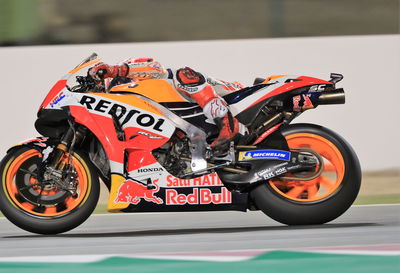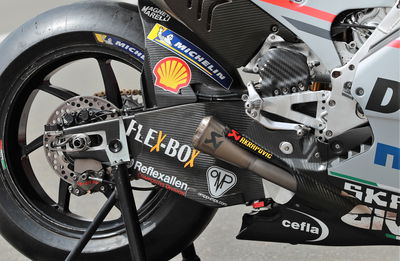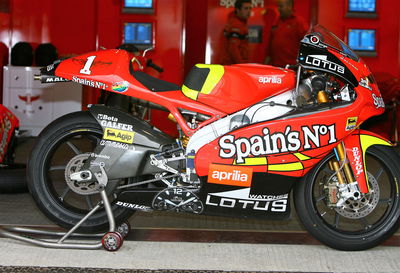Definitely Maybe: Carbon fibre swingarms in MotoGP
This winter saw Honda join Ducati in fitting a carbon fibre swingarm to its MotoGP prototype, in place of the usual aluminium.
After keeping their cards close to their chest during testing, Marc Marquez and Dani Pedrosa raced with the new composite design in the season-opening Qatar MotoGP.
That contest ended with carbon fibre swingarms first and second, due to Ducati's Andrea Dovizioso taking a narrow victory over Marquez.

This winter saw Honda join Ducati in fitting a carbon fibre swingarm to its MotoGP prototype, in place of the usual aluminium.
After keeping their cards close to their chest during testing, Marc Marquez and Dani Pedrosa raced with the new composite design in the season-opening Qatar MotoGP.
That contest ended with carbon fibre swingarms first and second, due to Ducati's Andrea Dovizioso taking a narrow victory over Marquez.
Meanwhile Aprilia, which used carbon fibre swingarms in 250cc, is also on the verge of using the technology in MotoGP with a debut test planned for Jerez this week.
So what are the benefits of making a swingarm from carbon fibre and why doesn’t everyone do it?
To find out more Crash.net spoke to MotoGP's Director of Technology, Corrado Cecchinelli, during the Qatar race weekend.
Before his current role, Cecchinelli worked for Piaggio and then Ducati.
And it was while Vice Director General of Ducati Corse, from 2006 to 2010, that the factory introduced its carbon fibre MotoGP swingarm, which the Desmosedici has kept since the end of 2009.
But although carbon fibre is definitely an advantage on paper, in the real world it's more of a maybe...
Crash.net:
Corrado, you were at Ducati during the start of the carbon fibre swingarm project?
Corrado Cecchinelli:
Yes. I was in Ducati when we started with the carbon fibre swingarm. It was not the first time it had been done, because it was already on the 250cc Aprilias for example.
Carbon fibre is the appropriate material if you are using big surface skins, but not small shapes. So, for me, it is the correct application for a swingarm, also because the swingarm is designed for stiffness.
That doesn't mean it is designed to be as stiff as possible, but that it is designed for a target stiffness.
Plus you want '3D' stiffness. For example, you want the swingarm to bend when the bike leans, but not to twist. With carbon fibre you can play with the orientation of the fibres to have the three-dimensional stiffness you want.
Also, in general, for a given target stiffness and taking into account the strength needed, most probably a swingarm will be lighter if it is made in carbon fibre than aluminium.
But I can tell you that when I was at Ducati, the MSMA tried to stop carbon fibre swingarms due to concerns that it is high cost. Which is true if you only consider the cost of one piece, but not one season of swingarms.
We were the joke of the MSMA because we were arguing it was a saving! But it's true because when you design an aluminium swingarm for a target stiffness it may become so thin that it cracks under normal use.
And this is what happens, even today! So carbon fibre is not automatically more costly.
However, it is definitely more difficult to make a swingarm with carbon fibre and one piece is more expensive than one piece of aluminium for sure.
Plus there are concerns about safety. This is not because carbon fibre is less safe, but because the outcome of a crash in terms of possible damage to the swingarm is more difficult to investigate with carbon fibre.
After a big crash you should send the swingarm back to the factory for X-rays and other complicated inspections. It is not something you can do at the track.
This is one more reason why carbon fibre is a costly part, because you have to have more spare parts, so you can change the swingarm after a big accident to be sure.
So there are issues about using carbon fibre. But still, if you ask me, it is the correct technology to manufacture a swingarm. Because of the advantages that I've mentioned.
Crash.net:
In that case, why doesn't everyone in MotoGP use them?
Corrado Cecchinelli:
First of all, if you are not pushing the [thickness] limit of aluminium in your swingarm design, then you won't have the problem of not enough strength with your target stiffness.
And in that case, the example I gave you of the cost of carbon fibre being cheaper over one whole season does not apply. Because if the aluminium is not designed to the extreme it will not need to be replaced as often.
And then there are the other reasons I told you: It's difficult to design, difficult to produce, suspect in case of a big crash. For all of these reasons the conventional technology is aluminium and it of course gives more than acceptable results, because it is the most common technology in use today.
But still carbon fibre is to me better, with drawbacks.

Andrea Dovizioso's Ducati swingarm, Qatar MotoGP 2018 (pic: Gold&Goose).
Crash.net:
So in terms of performance, you can get more flex with carbon fibre because you don't have the problem of making the aluminium too thin?
Corrado Cecchinelli:
In designing a swingarm for racing, you are looking for something that is anisotropic, meaning it has different stiffness properties in each direction.
Carbon fibre helps you with that because you can put more or less layers of carbon fibre in certain areas and you can have different orientations of the fibres. Changing the orientation of the fibres changes the stiffness.
The swingarm will probably also end up being lighter with carbon fibre, but you cannot forget that carbon fibre has a naturally different damping than aluminium.
So if you have problems like chattering, or vibrations in general, you may want to switch from one to the other [carbon fibre to aluminium or vice versa] simply due to the fact that the other swingarm will have a different weight and a different damping.
This is another reason to choose one or the other. It is very complicated, but the small difference in weight and inner damping may affect chattering a lot and vibrations in general.
Crash.net:
One popular conception is that carbon fibre is too stiff for motorcycle racing…
Corrado Cecchinelli:
That is not true! Stiffness is simply a design target.
In general, when designing mechanical parts, you may look first for a target stiffness or a target resistance [strength].
They do not always go together. If you are designing a hook to lift a large weight, your main design target is strength, which generally brings with it the highest stiffness possible.
But if you are designing a swingarm or a chassis, you are designing for a target stiffness. And, in reaching that stiffness target, you may fail to have enough strength. This may be the case with an aluminium swingarm.
For example, you may want it to be so flexible that you risk having cracks. Or - even if not that extreme, which happens - the metal sheet becomes so thin that welding is a problem. Things like this.
So parts that are designed for a target stiffness are not necessarily robust enough to be made of aluminium.
Crash.net:
That's interesting, because the perception is that when people go to carbon fibre they want something that is stiffer…
Corrado Cecchinelli:
No! They are looking for an ideal stiffness, but with less weight and more strength. Or they are looking for a better decoupling of the stiffness in each direction.
Because in general for a swingarm you want it to be able to act like the suspension on the lean, but not steer and not twist.
If you are good with carbon fibre you have, for sure, more chances to achieve that.
Crash.net:
Did you ever consider going back to aluminium once you'd tried carbon fibre?
Corrado Cecchinelli:
Yes, we did. In my time, we considered many times to go back and made a lot of back-to-back tests. But of course my last update is ten years ago!
Crash.net:
When you did the back-to-back tests did you always find that you were better off with the carbon fibre?
Corrado Cecchinelli:
No. It is not, to my knowledge, always better as a general choice. It is better on paper and it is sometimes better on the track. But it is not a general result.
First of all you make a list of your targets and it depends on what is your primary target.
For example, if I'm making a road bike, carbon fibre is out of the game because of the cost and because of what I told you about the possible damage in a crash.
Crash.net:
But in racing, where performance is the most important factor, it should be better?
Corrado Cecchinelli:
If you are very good at understanding what you need in terms of stiffness and you are very good at composite technology, then probably you'd better go with carbon fibre.
But it's not for all. I mean, if me and you make a race bike it's way better if we make it with steel pipes.
Because if you don't have a clear picture of what you really need and you don't handle the technology at the very high level you may end up in having a worse piece made of carbon fibre than of aluminium.
There are technologies involved that you have to dominate and if you can't dominate the carbon fibre technology, it's better to stay away.
But even before those manufacturing complications comes the need to clearly understand the problem, in order to believe that carbon fibre would help.
One of the most important reasons for carbon fibre is decoupling the stiffness in various directions - but if you don't know exactly what stiffness you want in each of those directions, for each load scenario, why do it?
If you were just to use carbon fibre layers like you would use aluminium, with all of the fibres running in the same direction and without true knowledge of the stiffness you need in each direction, to me you may even end up with a heavier piece or just something much more expensive with no real benefit.
So it's not always better.
If you remember the one from Aprilia in 250 for sure they were looking for the best stiffness-to-weight ratio and it incorporated the mud guard, to work with big skins as I said at the start. But of course this was a design that doesn't put cost high on the priority list, because if you crack the mudguard you must replace the whole swingarm!

Jorge Lorenzo's Aprilia, Jerez Test, 2007 (pic: Gold&Goose)
So there are a number of factors by which a manufacturer might end up with their most rewarding design material, which is not necessarily the same for all.
For instance, let's switch to the chassis, to me there is not one best material.
So if you are familiar with steel pipes [KTM], you'll end up with a better frame for your purposes by using that technology instead of a carbon fibre monocoque. Even though carbon fibre is a nobler technology on paper.
Crash.net:
The key to it all is knowing exactly what you want?
Corrado Cecchinelli:
If you don't know what you want, then you will never know how to achieve it.
And then, even if you know what you want, if you don't know how to manufacture the piece you design, you better stay with what you are confident with.
Carbon fibre is the correct material on paper because of non-symmetrical stiffness and because it's best suited to big-skin pieces like a swingarm. But to then actually make, in the real world, a better swingarm from carbon fibre than aluminium is a different story.
Crash.net:
Do you think it is just a coincidence that Honda and Aprilia are starting to use the technology on their MotoGP bikes this year?
Corrado Cecchinelli:
I don't know, it could just be something that is not clearly identified but driven by the new tyres maybe.
It might be a generation of tyre casings that makes carbon fibre suddenly better than aluminium, because of the material damping behaviour. But I'm just guessing.
Let's imagine you are an R&D department and you design your best carbon fibre swingarm possible and your best aluminium swingarm possible. You have half-a-kilo difference, so you give a try to the carbon fibre and it turns out to be better for chattering.
That depends on the tyre, but it was not your main target.
Crash.net:
You said half-a-kilo, is that roughly the weight saving?
Corrado Cecchinelli:
I think we are in that ball park, but I don't know for sure. I'd be surprised if you can save more than 1kg on a carbon fibre swingarm.
Crash.net:
Marquez said in testing that it 'looks like the grip is a little bit better with the carbon fibre, but then with the used tyre it’s shaking too much'…
Corrado Cecchinelli:
If we want to invent an answer to that case, we could suppose that the carbon fibre version he was using was stiffer than the aluminium, so it's better when you have grip but worse if you don't.
Crash.net:
Isn't carbon fibre most useful for less stiffness, compared to aluminium?
Corrado Cecchinelli:
I didn't say that. Carbon fibre gives you more chances to hit your exact target stiffnesses, whatever those may be.
Crash.net:
But you don’t have the problem of the metal becoming too thin to reach that target?
Corrado Cecchinelli:
Normally not, no. Because you can for instance use the direction of the layers to have a reasonable thickness without being too stiff. You can play more.
But it's like everything more sophisticated in life, only the good players get an advantage from it. Like if I go riding on a track, for me a 600cc road bike is much better than a 1000cc.
And with so many options in terms of stiffness, with carbon fibre you really have to dominate the technology. You have to understand what you need, how to design a piece to get what you need and then to manufacture it.
It's not within the reach of everybody.
Crash.net:
How long did it take you guys to master it?
Corrado Cecchinelli:
I don't remember exactly, but I would consider that to introduce a carbon fibre swingarm is a one season project. But then you may end up with completely the wrong piece, so it becomes a two season or never project!












